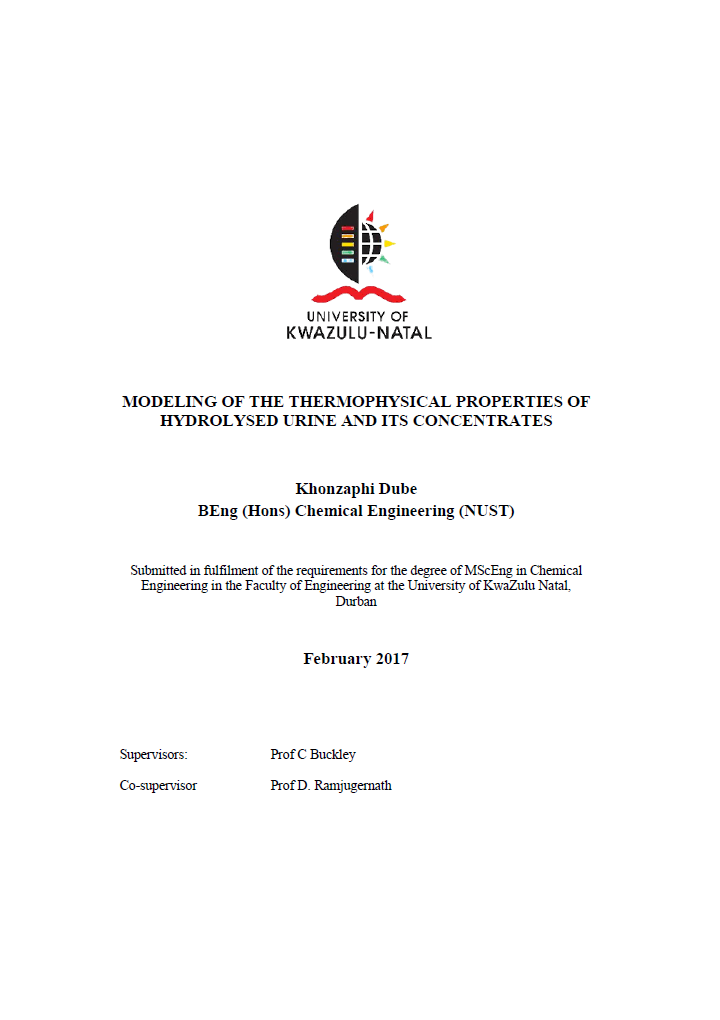Modelling of the Thermophysical Properties of Hydrolysed Urine and its Concentrates - Master thesis from the Pollution Research Group, at the University of KwaZulu-Natal (Durban, South Africa)
Dube, K. (2016)

Published in: 2016
Pages: 163
Author:
Dube, K.
Uploaded by:
Santiago Septien Stringel
Partner profile:
University of KwaZulu-Natal
2527 Views
17 Downloads
Location of library entry
Content - Summary
In 2011, the Bill and Melinda Gates Foundation launched the Reinvent the Toilet Challenge (RTTC) to provide sustainable, sanitary amenities for 2.6 billion people who lack access to suitable toilet facilities. 16 research groups, including the Pollution Research Group, were awarded grants to develop concepts and to design prototypes of a toilet that would provide safe and sustainable treatment of human waste. To this end, various technologies were proposed and developed for the treatment of urine, to recover valuable nutrients and water.
However knowledge of the thermophysical properties of urine is key in the engineering design and optimization of urine treatment technologies. The aim of this project was to provide the RTTC grantees with experimental data that will inform optimised designs of their urine treatment units, particularly those required for the design and optimum operation of thermal and membrane separation processes. The properties investigated include: vapour pressure; osmotic pressure; electrical conductivity; and density.
To investigate the thermophysical properties of urine, synthetic solutions of hydrolysed urine were prepared at a series of concentrations, up to 10 fold. High precision measurements were undertaken for each property at temperatures ranging from 293 to 373 K. Vapour pressure was measured using a static apparatus and osmotic pressure data was calculated from the vapour pressure measurements. The density of the solutions was measured using an Anton Parr DMA 5000 densimeter that uses the vibration principle and electrical conductivity measurements were performed using a commercially available dip style cell (YSI model 3200).
Modeling of the experimental data was undertaken to assist the design engineer to calculate the thermophysical properties from the composition of hydrolysed urine. Two existing techniques for modeling were applied. In the first method, a geochemical speciation software, PHREEQC, was used to determine the chemical equilibria and distribution of the ions in the urine solutions at varying temperatures and concentrations. The speciation data was incorporated into thermodynamic models to predict the properties of the urine solutions. In the second technique, existing correlative models were used to fit the experimental data to best fit equations. These models can be incorporated into computer software used in chemical engineering design processes.
The accuracy of both techniques was verified by comparing the model calculations to the experimental data. The calculated properties, using both modelling techniques, were in good agreement with experimental data, and the average deviations were within ±2.0% for the studied concentration and temperature ranges. In conclusion, cases studies were done, to demonstrate the use of the urine data and models in the design of a multiple effect evaporator, thermal recompression evaporator, forward osmosis and reverse osmosis processes.
Additional information
Supervisors: Dr. Santiago Septien Stringel; Pr. Deresh Ramjugernath, Dr. Konstantina Velkushanova, Pr. Chris Buckley
Bibliographic information
Dube, K. (2016). Modelling of the Thermophysical Properties of Hydrolysed Urine and its Concentrates - Master thesis from the Pollution Research Group, at the University of KwaZulu-Natal (Durban, South Africa).
Filter tags
Case studies in other formats English Sub-Saharan Africa Urine















